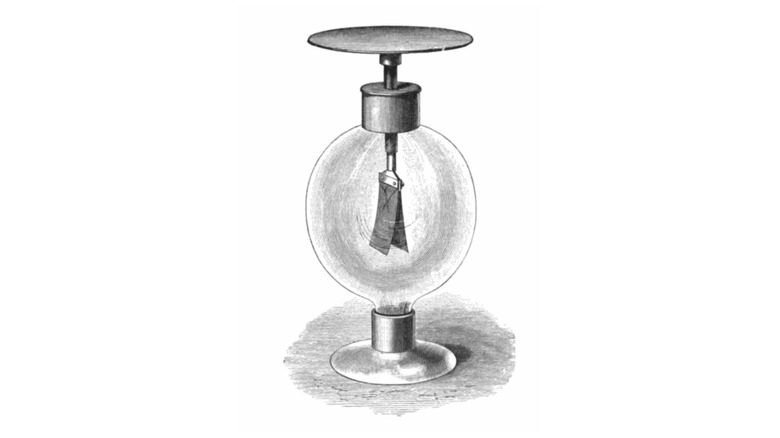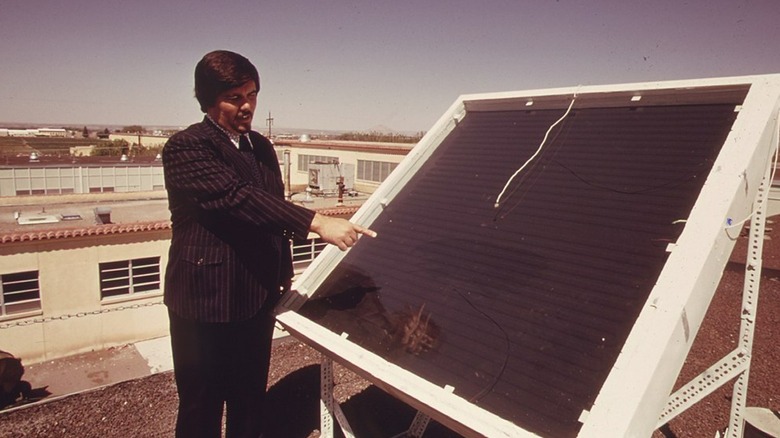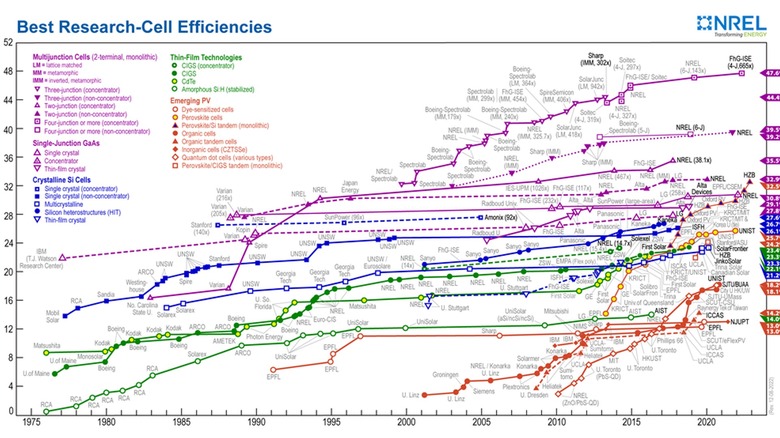The Evolution Of Solar Energy: How Solar Panels Have Changed Over The Years
The landscape of solar energy production and use is widespread and comprehensively developed today. Sure, research still hasn't created a consistently efficient means of storing solar power in the long term. But photovoltaic (PV) cells do translate solar power into electrical energy that can be used to charge (and then discharge) lithium-ion batteries, among others, though efficiency loss along the way can make it a challenge for residential users. Even so, solar farms around the country and world have transformed the way humans produce electrical energy, and residential systems are delivering increased energy independence alongside improved environmental security.
The journey from early exploits in harvesting the sun's energy to this present moment and beyond is a fascinating one. Ancient humans harnessed our star's potential in many ways, and modern inhabitants of the Earth have followed suit, albeit with increasingly impressive technological breakthroughs that make the sun increasingly valuable. The contemporary solar panel owes its existence to a long string of advancements that begin far back in history — but really came into their own over the last couple hundred years. This is the evolution of the solar panel.
Harvesting the sun's rays in antiquity
As early as the 7th century B.C., humans were using the sun to start fires with the help of rudimentary magnifying glass technology. These experiments with solar power set the baseline for humanity's partnership with the sky's ancient energy producer, and they stand the test of time — young students still go outside to create heat and tiny burn marks under the supervision of their teachers. Thousands of years after those early harnessers, Chinese and Greek civilizations built cities with the sun's position in mind.
These communities crafted homes and gathering places directly affected by the sun's position in the sky, changing them throughout the year to accommodate weather patterns and comfort requirements. They used the sun's trajectory and the year's seasonal pattern to harness the star's heat during the winter and create a cooling effect in the summer months. These early efforts to capture the sun's radiant energy colored the way humans thought about the celestial body for centuries to come. It would be thousands of years before humanity found that it could truly capture and manipulate the sun's energy, but that voyage starts here, in antiquity's first steps.
The first solar cell is developed in 1767
Solar energy was conceptualized in a whole new light after Horace Benedicte de Saussure created the first cell in 1767. The Swiss intellectual began toying with a design for solar capture that might help harness the sun's energy. Saussure is famous for exploring the Alps and performing a range of geological testing and measurements. In 1767, he created the heliothermometer, a device that magnified incoming sunlight to produce an increased heat output. Saussure's heliothermometer was constructed of layered glass in an insulated box. Essentially the device acted like a small greenhouse that would gradually raise the temperature so that the sun's light energy could be transformed into heat. The device amplified the heat enough to reach 108 degrees Celsius, breaching the boiling point of water and allowing users to leverage the sun's energy for cooking and other rudimentary tasks.
At this point, solar capture technology obviously wasn't very efficient, but Saussure's breakthrough laid the foundation for all other solar cell technologies that arrived over the next 250-plus years. It might be hard to believe that this cutting-edge technology got its start such a long time ago, but it really begins here with the understanding of how to reliably convert sunlight into a usable alternative energy format.
Featured image by Jens Juel via Wikimedia Commons | Cropped and scaled | Public domain]
The photovoltaic effect is discovered in 1839
In 1839, roughly 70 years after the first solar cell was created, Edmond Becquerel observed the photovoltaic effect in action, kick-starting a revolution in human understanding of solar energy — and power production and usage more broadly. At this point, experimentation with electrical power is in full swing, although the first American power grid technology was still a few decades away. The photovoltaic effect is a foundational principle underpinning the very existence of modern solar technology. In a nutshell, Becquerel observed that certain materials produce electric current when they're exposed to sunlight or even radiant heat.
At just 19, Becquerel made this breakthrough while researching in his father's lab. After this inflection point, it became clear that solar capture technology doesn't require an additional translation of energy to utilize the resource after it has been collected as light. Early solar capture revolved around creating heat, but this must be translated again in order to develop an electric charge that might power a machine, light bulb, or automotive vehicle. With each conversion, energy is lost — another foundational principle — meaning the ability to generate electrical current directly from collected sunlight saved incredible space, time, and energy itself.
[Featured image by Nadar via Wikimedia Commons | Cropped and scaled | Public Domain]
1883: Charles Fritts builds a modern solar capture cell
The selenium cell is the next major breakthrough for solar power production. Charles Fritts continued the progress of many other inventors in the arena, settling on selenium after other pioneering research into its photoconductivity. In 1883, Fritts successfully created the first solid material solar cell, requiring no moving parts to capture sunlight and output an electric charge that could be harnessed to support human needs.
Fritts' cell created electricity at an efficiency conversion rate of about 1% or 2%, but it was the breakthrough required for crafting increasingly useful electricity-generating solar cells. As reported by Smithsonian Magazine, Fritts joyfully noted of his selenium creation that it produced an electric current that was "continuous, constant, and of considerable force." The improvement made for a major leap forward in solar power creation. No longer did users have to rely on bulky productions or moving components that made the tool far more complicated. The solar cell was coming into form.
Photoelectric processes are observed and improved cells make their appearance
Building on the existing principles of the photovoltaic effect, a similar phenomenon — photoelectric effect — was observed in 1887 by German physicist Heinrich Hertz. This is when electrons are emitted into space rather than entering what is known as the conduction band of the material in question. Hertz noticed that shining UV light on the nodes created sparks between electrodes, eventually uncovering this related phenomenon.
A year later, Aleksandr Stoletov had built a working photoelectric cell, the first of its kind. Perhaps the most important feature of this competing design was found in Hertz's discovery that more electric power is created from exposure to ultraviolet light than in the visible spectrum. Considering the vast, radiant output of UV rays from the sun, this new finding and resulting breakthrough created an exciting new avenue to pursue in the quest for ever-increasing solar power efficiency and functionality.
[Featured image by James Edward Henry Gordon via Wikimedia Commons | Cropped and scaled | Public domain]
Silicon solar cells hit commercial production
Steady progress continued after these early breakthroughs, but explosive growth began to take root in the 1950s. Early in the decade, Bell Laboratories developed the silicon solar cell, bringing energy-producing efficiency up to 6%. Still notably lower than modern residential efficiency standards (around 20%), this was a big change from the low numbers that the first wave of solar collection tools were able to muster. Indeed, cells of this era were suddenly capable of powering equipment used in labs, homes, and elsewhere. In 1958, solar collection tools were deployed in space exploration equipment to provide consistent power to devices that would live out in the great beyond alongside their energy progenitor.
The boost in production efficiency was due in large part to the inclusion of silicon in the design rather than the earlier use of selenium. It offered greater efficiency, but at this stage the costs remained prohibitive for all but the most specialized uses. Case in point: In 1958 NASA launched Vanguard 1, a satellite that has now traveled nearly 200,000 times around the Earth on the backs of photoelectric solar panels. Research and specialty uses remained the overwhelming use of solar technology, but changes were stirring behind the scenes.
[Featured image by NASA via Wikimedia Commons | Cropped and scaled | Public domain]
Exxon Corporation research pours money into the technology
Throughout its time in contemporary existence, solar power has faced off against two mortal threats. In the technology's modern framework, price and efficiency act as dual barriers to comprehensive adoption and severely challenge any model of environmental and power grid sustainability that relies primarily on solar to supplant environmentally damaging practices. Coal-fired industrial production might be dirty and unsustainable over the long term, but the excessive costs associated with building solar collectors and then running them at an abysmal efficiency rating make it a non-starter in the present.
In the 1970s, things began to shift in both regards, however. Exxon Corporation research began taking off, and the U.S. government got serious about projects designed to create more robust energy independence. The Solar Energy Research, Development, and Demonstration Act of 1974 saw federal dollars poured into solar projects aimed at making solar practical and affordable so the public could easily access the benefits of this new energy option. Meanwhile, Exxon's studies focused on reducing costs, and the company succeeded in reducing the price of solar-created electricity down from $100 per watt to as low as $20. This still wasn't enough to make it directly competitive with its alternatives, but the framework for a viable path forward was certainly beginning to take shape.
[Featured image by Boyd Norton via Wikimedia Commons | Cropped and scaled | Public domain]
20% efficiency is achieved in 1985
The second barrier to widespread adoption came in the form of efficiency. Wave energy capture technology has recently found ways to deal with this issue, and in 1985, it appeared that solar cells had as well. The University of South Wales broke the 20% barrier in silicon cells in 1985, and solar buildings, parks, and other large-scale construction projects were cropping up all over the country and globe around this time, too. It's also important to note that the 1980s saw another wave of crippling energy crisis years, spurring a global economic recession.
Just a few years earlier, in 1982, the first solar-powered car was driven from Sydney to Perth (around 2,800 miles) in half the time it took the first gasoline-powered car to achieve the feat. Global adoption rose past 21.3 megawatts of production in 1983, as well. In 1992, a decade after these new developments, researchers at the University of South Florida broke the 15% efficiency barrier for the first time with a thin-film photovoltaic solar cell (made of cadmium telluride and clocking in at 15.9% efficiency). A year after that development Pacific Gas & Electric installed the first grid-supported photovoltaic system. It was a 500-kilowatt endeavor in Kerman, California, and the first solar-distributed power system built. Another year later, the National Renewable Energy Laboratory broke the 30% energy conversion threshold with a new solar cell design that utilized gallium indium phosphide and gallium arsenide.
[Featured image by Nikos Kopidakis via Wikimedia Commons | Cropped and scaled | Public domain]
By 2010, solar power production is booming across the United States
As Boston University Institute for Global Sustainability documents, power production through solar technology has exploded in the United States over the last two decades. The introduction of the Solar Investment Tax Credit in 2006 spurred a major shift in the way enterprise and residential power production and usage was considered, and by 2010 solar power production had become a nearly monolithic new opportunity. In North Carolina — and California, specifically — new solar power construction projects jump off the map. Following these early adopters, the Maryland and New Jersey-New York coastline and a smattering of insular communities in Colorado, New Mexico, and across the Midwest began to see massive investment in solar power construction.
These projects have brought gigantic financial investment into communities that may have formerly relied on coal mining, oil drilling, fracking, and other formats of energy harvesting. An evolution of the energy sector's workforce began taking place around 2010, and it hasn't slowed down in the 14 years since. In coordination with the 2006 legislation, 2009 saw the American Recovery and Reinvestment Act signed into law, expanding tax breaks, grants, and other incredible financial incentives for companies to develop solar power infrastructure.
Tax incentives today make residential solar energy a true option
Today, the efficiency of most residential solar panels sits at around the 20% mark, on average. With prices continuing to drop — a 70% reduction in the price of installation over a 10-year period around the time of key legislative victories for the burgeoning solar industry — residential panels are increasingly viable. In fact, the Office of Energy Efficiency & Renewable Energy reported in 2017 that the solar industry created roughly 1,000 new jobs every week. In addition, tax breaks and other financial incentives extended to residential users have made it an affordable solution in both the here and now, and over the long term as a means to reduce continuing energy usage costs. Current tax incentives offer up to a 30% recovery of installation costs, running between 2017 and 2034, with rollover credits available to installing homeowners (and perhaps even solar-installing renters) so that they can utilize the full financial value.
Those who have installed solar panels on their homes can also take advantage of banking, net metering, and energy sell backs, as well. With added battery technology in the home, residential users can now bank surplus energy captured through the home system. States have also mandated that users can sell back the surplus energy generated to their power company for an added offset to their electricity bill. Continued technological improvement and government programs have made solar power a truly valuable option both in the commercial and residential space.










